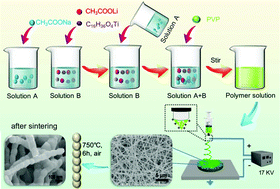Scalable synthesis of one-dimensional Na2Li2Ti6O14 nanofibers as ultrahigh rate capability anodes for lithium-ion batteries†
Abstract
Carbon anode materials for Li-ion batteries have been operated close to their theoretical rate and cycle limits. Therefore, titanium-based materials have attracted great attention due to their high stability. Here, Na2Li2Ti6O14 nanofibers as anode materials were prepared through a controlled electrospinning method. The Na2Li2Ti6O14 nanofibers presented superior electrochemical performance with high rate capability and long cycle life and can be regarded as a competitive anode candidate for advanced Li-ion batteries. One-dimensional (1D) Na2Li2Ti6O14 nanofibers are able to deliver a capacity of 128.5 mA h g−1 at 0.5C, and demonstrate superior high-rate charge–discharge capability and cycling stability (the reversible charge capacity is 77.8 mA h g−1 with a capacity retention of 99.45% at the rate of 10C after 800 cycles). The 1D structure is considered to contribute remarkably to increased rate capability and stability. This simple and scalable method indicates that the Na2Li2Ti6O14 nanofibers have a practical application potential for high performance lithium-ion batteries.



 Please wait while we load your content...
Please wait while we load your content...